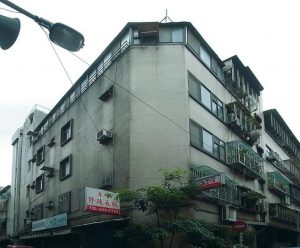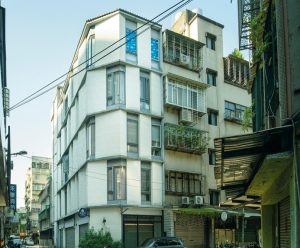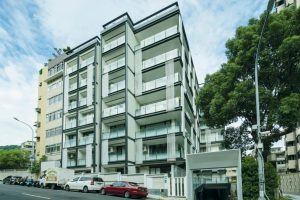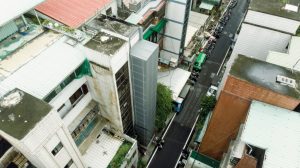Breathing New Life into Old Apartment Buildings
By Chen Yi-zhen (陳怡臻)
Photos by Tzu Cheng Liu (劉子正)
Abridged and translated by Dennis Chang (張國雄)
Shawn Chang (張牧軒)
Syharn Shen (沈思含)
Breathing New Life into Old Apartment Buildings
By Chen Yi-zhen (陳怡臻)
Photos by Tzu Cheng Liu (劉子正)
Abridged and translated by
Dennis Chang (張國雄)
Shawn Chang (張牧軒)
Syharn Shen (沈思含)
A major part of Taiwan’s urban housing landscape, decades-old apartment buildings now face the possibility of being demolished in the name of modernization.
Imagine yourself walking towards the balcony of your home in the morning. With a light breeze softly caressing your face, you see an open view of the landscape. At your feet, some potted plants you’ve grown are basking in the sun, and your beloved bicycle is parked by one corner of the balcony. Is this how you picture your ideal balcony? With some careful planning, it is possible to make it into a reality.
Statistics show that nearly 80 percent of people in Taiwan live in metropolitan areas, which means that for most people, a comfortable urban residence is the key to having a quality life. A large population of city residents shares the experience of living in a four- to five-story apartment building that is commonly seen in Taiwan. But over the years, most of these apartments have fallen into disrepair and cannot keep up with the needs of people nowadays. Some became unclean and disorderly due to lack of proper management. Moreover, due to Taiwan’s humid climate, the exterior walls of these buildings, usually made of concrete, tiles, or building stone, are prone to aging, weathering, and collecting dirt. For this reason, the old apartments not only present an unsightly streetscape, but also pose a threat to public safety as building materials often come off and fall on pedestrians or vehicles passing by.
As we age, our metabolism slows down, our immune system declines, and our bodies weaken. Yet we won’t destroy ourselves just because we are ageing, but will instead try to stay healthy by seeking medical treatment or taking care of our diet and lifestyle. Like our bodies, buildings also deteriorate over time. With Taiwan’s modernization, four- to five-story apartment buildings sprang up and played an important part in shaping a housing culture that most city dwellers are familiar with. It’s only natural that Taiwanese city residents wouldn’t want to tear down these apartments—along with the shared memories—simply because they are old and in disrepair.
Exterior Renovation: Giving Old Buildings a Facelift
“An attractive building is an additional benefit of renovation. The key focus should be improving the building’s condition and upgrading it to meet modern needs.” said Wu Sheng-ming (吳聲明), an architect with many years of experience renovating old buildings. He pointed out four major issues when renovating an old building—exterior remodeling, elevator installation, structural reinforcement, and the integration of its residents’ opinions.
Just as exercise and make-up can make an ageing person look young and energetic, exterior remodeling can renew an old building’s look while fixing leaks, cracks, and loose tiles from its external walls. So, exterior remodeling can be seen as the first step in old building renovation.

JiLin Apartment(before renovation)

JiLin Apartment (after renovation)
“As a corner building, it already had better natural lighting and ventilation than most apartment buildings. But its interior space was as small as other old apartments, and there was no elevator for elder residents or people with disabilities. Moreover, as the building was over 30 years old, there were leaks in its exterior walls and roofs. Located by a road leading to an MRT station, it posed safety concerns for its residents as well as people in the neighborhood,” Wu described the condition of JiLing Apartment before its renovation.Located near the MRT Xingtian Temple Station in Taipei, JiLin Apartment stands in a corner of an old and typical urban community. It looks modern, yet not out-of-place with its surroundings. Renovated by Wu Sheng-ming eight years ago, it is now a must-see for architecture enthusiasts.
When it comes to lighting, most people may long to have large windows in their homes so they can wake up in the morning by the sunlight streaming in, or enjoy reading in the living room filled with soft and gentle sunshine. Unfortunately, not all apartment buildings enjoy the benefits of adequate natural lighting. Overheating as a result of a western exposure, for instance, is a common problem for many apartment buildings in Taiwan.In remodeling the exterior of the building, Wu removed the old tiles of the exterior walls and installed large French windows to further increase the building’s ventilation and natural lighting. Furthermore, he used ceramic fiber plates to create a zigzag façade, so when the sun shines on the apartment, one can see the changing movement of light and shadows from different angles. It’s like putting a breathable, waterproof, and stylish GORE-TEX jacket on the apartment—the building is shielded from rain and outside heat while the privacy of its residents is protected.

The exterior of Yanjing Mansions
Yanjing Apartment, a seven-story old building in Tianmu’s neighborhood of Taipei, is a case in point. Before its renovation, it had problems commonly seen in old apartment buildings, such as low ceilings on each floor (causing heat and humidity to gather indoors), narrow balconies (not user-friendly), and a western exposure to the sun. “When sunlight pierced into the apartment, it was hard on the eyes. The room temperature would increase, and it’d be sweltering. During summertime especially, I could hardly stay inside without air conditioning,” said one of its residents, recalling how it was like living in the apartment before its renovation.

A renovated balcony in Yanjing Apartment
To address all these issues, the architect in charge of renovating the apartment first expanded the balconies, turning them into a space for storage, growing plants, or leisure activities. Next, he replaced the original balcony walls made of concrete with clear glass panels for a spacious and translucent look. For adequate interior lighting, he also installed vertical fences in strategic locations to block off excessive sunlight from penetrating the apartment while offering more privacy for its residents.
Interior Renovation: Renewing the Structure, Piping, and Wiring
Apart from exterior remodeling, interior renovation is essential as well. If we compare a building to a human body, then its piping and wiring are like blood vessels, and the structure of the building its skeleton. These systems are indispensable in ensuring the normal functioning of a building.
“Piping, wiring, building materials, and other fundamentals are of utmost importance when renovating an old building,” said a homeowner in Kaohsiung, southern Taiwan. Even though she had no background in interior design, the homeowner renovated her old apartment in only four months. She advised that a house over 15 years old should have its piping and wiring completely replaced to avoid problems such rusting, clogging or bursting of pipes and prevent fires caused by electric overload or old wiring.
“Old house renovation is an ongoing process. It’s impossible to have it done once and for all. Rather, it requires a yearly routine maintenance for each component of the house. It may sound troublesome, but in the long run, through working with various professionals, you’ll eventually establish connections with a group of trustworthy experts who will make things easier during maintenance and when problems arise,” she added.
In addition to renewing the piping and wiring systems, strengthening the structural safety is also a crucial part in renovating an old apartment building, especially in earthquake-prone Taiwan.
In February 2016, a major earthquake struck southern Taiwan, causing the collapse of the Weiguan Jinlong building in Tainan. More than 200 people were reported dead or injured in that incident. The death toll even exceeded that of Dongxing Building, a building that collapsed during the infamous 921 earthquake that struck Taiwan on September 21, 1999. Undoubtedly, due to Taiwan's location on an earthquake hotspot, Taiwanese people will always have to deal with the issue of frequent earthquakes.
According to statistics from Taiwan’s Ministry of the Interior, approximately 86,000 apartment buildings across Taiwan were constructed more than 30 years ago. Among these old apartments, an estimated 34,000 buildings fail to meet standards for earthquake resistance, which means that if a strong earthquake of magnitude 7.0 or greater strikes Taiwan, the consequences will be unthinkable.
To determine the structural safety of one’s apartment building, a technical expert experienced in assessing the condition of old buildings suggests as the first step to seek professional help from trustworthy organizations for inspection, assessment, and advice.
Zhou Bao-wen (周寶文), owner of the renovated We Love Apartment in the southern city of Tainan, believes that even the most complex and glamorous renovation must be built on a solid and stable structure.
Now home to a B&B, Zhou’s apartment is over 50 years old and was in a state of disrepair with structural safety issues. "All the remodeling and modifications had to rely on the support at the center of the building—a pillar made three times as thick as the original column."
An Increasing Demand: Remodeling to Meet the Needs of the Elderly
As the world’s ageing population grows, new housing needs for the elderly will inevitably arise. According to the World Health Organization, a society in which more than 7%, 14%, and 20% of the population is aged 65 years and over is an “ageing society,” an “aged society,” and a “super-aged society” respectively. In April 2018, Taiwan has officially become an aged society, and is forecast to become a super-aged society in eight years.
However, most old apartment buildings in Taiwan have no elevators. And as Taiwan’s population continues to age, there will be more and more elderly people living in these apartments, making the installation of elevators necessary. But the truth is, for most apartment buildings in Taiwan’s urban areas, elevator installation projects often end in failure due to disagreement among property owners.

An old apartment building in New Taipei City with an elevator installed.
In New Taipei City, home to the highest number of old apartments in all of Taiwan, there are roughly 680,000 old buildings (aged 30 or older) without elevators. Despite the fact that since 2010, the local government started to promote elevator installation in old apartments by providing subsidies of up to half of the installation costs, only five elevator installation projects have been approved and only two of them have been completed. “The main problem lies in disagreements between the people involved,” said an official from the Urban Redevelopment Office of New Taipei City Government.
While the local government will subsidize up to half of the installation costs, the building residents still need to pay for the rest. Moreover, the consent of the property owner is required for elevator installation. These factors make it difficult for the people involved to reach an agreement on the project. “Residents on the higher floors may want an elevator installed, but those on the lower floors may think it’s unnecessary. Also, there will be additional fees to pay such as maintenance and higher electricity bills. And although the first-floor residents don’t have to pay for the installation, they might not be willing to go through all the noise and inconveniences. That’s why it’s so hard to reach an agreement,” said the official. With the state of things, it seems that there is still a long way to go for most residents of old apartments before they can create a living environment that meets the needs of everyone involved.
Apart from installing an elevator, other remodeling considerations to accommodate the needs of the elderly include housekeeping, house repairs, home safety, home care, medical care, diet and nutrition, health and exercise, as well as needs for transportation, company, and others.

Home remodeling can be planned to better meet the needs and interests of its retired residents.
According to a survey conducted by the Industrial Technology Research Institute (ITRI) at the end of 2017, home repair and improvement is the top concern of retired seniors, and nearly 90 percent of them are willing to pay for it.
“Surprisingly, home repair and improvement, rather than health-related needs, turned out to be the number-one concern of senior citizens. But thinking about it, it’s not hard to imagine the troubles an elderly person has to face when lights or water pipes need to be fixed. That is why their demand for home repair and improvement is at the top of their list,” explained Zhang Ci-ying (張慈映), a member of the ITRI.
Home improvements for the elderly also include grab bars, walk-in bathtubs, anti-slip floor stickers, flooring with no height differences, personal pagers and alarms, additional lighting, motion sensor lights, accessible stairs, and outdoor wheelchair ramps, etc. The demand for these home improvements that cater to the needs of the elderly will certainly increase as the population continues to age and seek a better quality of life in their golden years.
Home Renovation: A Difficult yet Rewarding Process
“When one walks into a home, sincere hospitality can be felt through the homeowner's arrangement of its space and atmosphere. The living space is a reflection of the homeowner’s inner world,” an interior designer once said when expressing his views on home renovation. “Because it is our home, we will be determined to face whatever difficulties that arise with it, and still find joy in the process of making it better.” These words may serve as a piece of advice for those taking up home renovation.
“Current urban renewal projects in Taiwan are all about tearing down old buildings completely to erect brand-new ones, and as consequence, the urban housing culture of the past and the collective memory of city residents have been slowly erased by new high rises on the streets,” architect Wu Sheng-ming sums up the mainstream mode of Taiwan’s urban redevelopment. “What we need is a change in perspective. Through the integration of exterior renovation and interior design, old apartment buildings can be completely transformed to offer comfort and value to its residents and the neighborhood. Starting with ourselves and our own homes, we’ll find that small efforts can bring about big changes,” concluded Wu.
From housing regulations to urban renewal programs, and from weather considerations to public opinion, Taiwan’s housing problems are as complicated as they can be. But, as long as residents are willing to spend time and resources on renovating their existing homes, they can create safe, comfortable, and delightful living spaces that breathe new life into old apartment buildings.
Contact Us | Plan a Visit | Donate
8 Lide Road, Beitou 11259, Taipei, Taiwan
886-2-2898-9999
005741@daaitv.com
©Tzu Chi Culture and Communication Foundation
All rights reserved.
